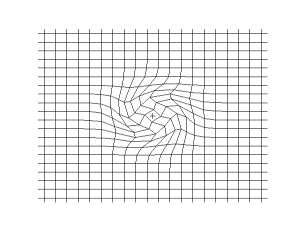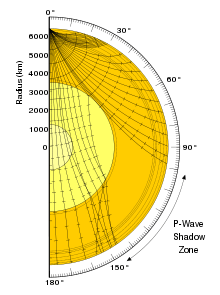S-wave
| Part of a series on |
| Earthquakes |
|---|
| Types |
|
|
| Causes |
| Characteristics |
|
|
| Measurement |
| Prediction |
| Other topics |
|
In seismology, S-waves, secondary waves, or shear waves (sometimes called an elastic S-wave) are a type of elastic wave, and are one of the two main types of elastic body waves, so named because they move through the body of an object, unlike surface waves.[1]
The S-wave moves as a shear or transverse wave, so motion is perpendicular to the direction of wave propagation. The wave moves through elastic media, and the main restoring force comes from shear effects.[2] These waves do not diverge, and they obey the continuity equation for incompressible media:
Its name, S for secondary, comes from the fact that it is the second direct arrival on an earthquake seismogram, after the compressional primary wave, or P-wave, because S-waves travel slower in rock. Unlike the P-wave, the S-wave cannot travel through the molten outer core of the Earth, and this causes a shadow zone for S-waves opposite to where they originate. They can still appear in the solid inner core: when a P-wave strikes the boundary of molten and solid cores, S-waves will then propagate in the solid medium. And when the S-waves hit the boundary again they will in turn create P-waves. This property allows seismologists to determine the nature of the inner core.[3]
Theory
The prediction of S-waves came out of theory in the 1800s.[4] Starting with the stress-strain relationship for an isotropic solid in Einstein notation:
where is the stress, and are the Lamé parameters (with as the shear modulus), is the Kronecker delta, and the strain tensor is defined
for strain displacement u. Plugging the latter into the former yields:
Newton's 2nd law in this situation gives the homogeneous equation of motion for seismic wave propagation:
where is the mass density. Plugging in the above stress tensor gives:
Applying vector identities and making certain approximations gives the seismic wave equation in homogeneous media:
where Newton's notation has been used for the time derivative. Taking the curl of this equation and applying vector identities eventually gives:
which is simply the wave equation applied to the curl of u with a velocity satisfying
This describes S-wave propagation. Taking the divergence of seismic wave equation in homogeneous media, instead of the curl, yields an equation describing P-wave propagation. The steady-state SH waves are defined by the Helmholtz equation
where k is the wave number.
See also
References
- ↑ What are seismic waves? UPSeis at Michigan Tech
- ↑ S wave US Geological Survey
- ↑ University of Illinois at Chicago (17 July 1997). "Lecture 16 Seismographs and the earth's interior". Archived from the original on 7 May 2002. Retrieved 8 June 2010.
- ↑ In 1830, the French mathematician Siméon Denis Poisson (1781–1840) presented a theory of the propagation of elastic waves in solids: Poisson, S. D. (1831), "Mémoire sur la propagation du mouvement dans les milieux élastiques" (Memoir on the propagation of motion in elastic media), Mémoires de l'Académie des Sciences de l'Institut de France, 10 : 549–605.
On pp. 595–596 of his memoir, he states that an earthquake would produce two different waves, one having a speed a and the other having a speed a / √3. From pp. 595–596: "On verra aisément que cet ébranlement donnera naissance à deux ondes sphériques qui se propageront uniformément, l'une avec une vitesse a, l'autre avec une vitesse b ou a / √3 ... " (One will easily see that this quake will give birth to two spherical waves that will be propagated uniformly, one with a speed a, the other with a speed b or a / √3 ... )
On pp. 602, Poisson states that of the two kinds of waves that an earthquake generates, one wave consists of expansions and compressions propagating parallel to the wave's direction of motion, whereas the other wave consists of stretching motions occurring in a plane perpendicular to wave's direction of motion. From p. 602: " ... à une grande distance de l'ébranlement primitif, et lorsque les ondes mobiles sont devenues sensiblement planes dans chaque partie très-petite par rapport à leurs surfaces entières, il ne subsiste plus que des vitesses propres des molécules, normales ou parallèles à ces surfaces ; les vitesses normal ayant lieu dans les ondes de la première espèce, où elles sont accompagnées de dilations qui leur sont proportionnelles, et les vitesses parallèles appartenant aux ondes de la seconde espèce, où elles ne sont accompagnées d'aucune dilatation ou condensation de volume, mais seulement de dilatations et de condensations linéaires." ( ... at a great distance from the original quake, and when the moving waves have become roughly planes in every tiny part in relation to their entire surface, there remain [in the elastic solid of the Earth] only the molecules' own speeds, normal or parallel to these surfaces ; the normal speeds occur in waves of the first type, where they are accompanied by expansions that are proportional to them, and the parallel speeds belonging to waves of the second type, where they are not accompanied by any expansion or contraction of volume, but only by linear stretchings and squeezings.) - ↑ Sheikhhassani, Ramtin (2013). "Scattering of a plane harmonic SH wave by multiple layered inclusions". Wave Motion. 51 (3): 517–532. doi:10.1016/j.wavemoti.2013.12.002.
Further reading
- Shearer, Peter (1999). Introduction to Seismology (1st ed.). Cambridge University Press. ISBN 0-521-66023-8.
- Aki, Keiiti; Richards, Paul G. (2002). Quantitative Seismology (2nd ed.). University Science Books. ISBN 0-935702-96-2.
- Fowler, C. M. R. (1990). The solid earth. Cambridge, UK: Cambridge University Press. ISBN 0-521-38590-3.


